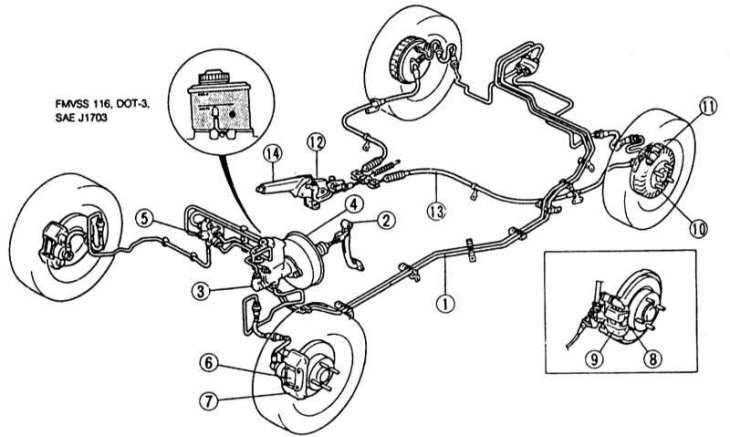
1 - brake pipeline; 2 - brake pedal; 3 - main brake cylinder; 4 - brake booster; 5 - brake pressure distributor; 6 - front disc brake; 7 - brake caliper; 8 - rear disc brake; 9 - brake caliper; 10 - rear drum brake; 11 - wheel brake cylinder; 12 - hand brake; 13 - hand brake drive; 14 - hand brake lever
The braking system consists of a master cylinder, brake booster, front wheel disc brakes and rear wheel drum brakes. Some models also have disc brakes on the rear wheels. The hydraulic braking system is divided into two circuits acting diagonally. One brake circuit acts on the right front/left rear wheels, the other circuit acts on the front left/rear right wheels. As a result, if one of the circuits fails, for example due to leaks, the vehicle can be stopped by the other circuit. When the brake pedal is depressed, the dual brake master cylinder is pressurized for both circuits. The brake pressure distributor connected after the master cylinder ensures that the rear wheels do not lock up during hard braking. The compensation tank with brake fluid is located in the engine compartment above the master brake cylinder and provides the entire system with brake fluid. The brake booster on a gasoline engine stores some of the low pressure produced by the engine. If necessary, the force of pressing the pedal is increased by vacuum. Since there is not enough suction vacuum on a diesel engine, low pressure for the brake booster is created by a vacuum pump mounted on the rear of the generator. Disc brakes are equipped with floating calipers. The floating caliper uses only one piston to push both brake pads against the disc.
The hand brake acts on the rear wheels through a cable drive. Disc and drum brake pads are automatically adjusted; basic adjustment is only necessary after a repair, in which the brake system was dismantled. Depending on the model MAZDA 323 from 10/89. issue can be equipped with an anti-lock system (ABS). The work described here applies to all variants of the MAZDA 323, regardless of whether they have ABS or not.
When cleaning the brake system, brake dust is raised. This dust can be harmful to health. Therefore, when cleaning the brake system, make sure that this dust is not inhaled.
Brake pads are specified for each model at the factory. Therefore, it is recommended to use only branded pads recommended by MAZDA.
Note. After installing new brake pads, they should run in. For the first 200 km, full braking should not be made unnecessarily.
Attention! Work on the brake system requires cleanliness and precision. In the absence of the necessary work experience, work on the brake system must be carried out in a special workshop.
